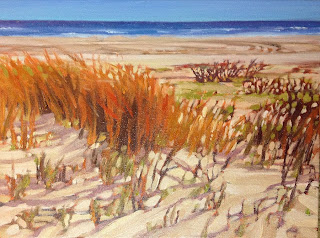Soft pastels are one of my favorite mediums. The colors in pastels, particularly the earth tones, blues, and reds, are among the most vivid colors you can find in any medium. Pastels are very versatile and lend themselves to a wide range of techniques. You can blend them for a smooth and fine finish, layer and scumble them for texture with or without fixative, and even liquefy them into a kind of paint-like paste with water.
Edgar Degas was the early and undisputed master of the pastel medium, and his vivid ballet dancers and nudes are among my most lasting influences. Life drawing was a big part of my foundation in art school at Lamar University. Lately I've been inspired to get back to working from the human form.
This is a small 8" x 12" pastel painting of my favorite model. In what seems like life coming round in a perfect circle, Elizabeth was also one of my favorite models twenty years ago when I was in college. She has amazing, tight spiral curls of red hair and a statuesque, curvy figure. All that red is perfect for pastels!
For this painting I chose a textured, middle grey Strathmore paper to start. I was envisioning the scumbled, heavily textured surfaces of Degas' work.
I began with a charcoal drawing. A careful drawing isn't necessary, but for this drawing I decided I wanted to be fairly specific and certain of the anatomy and composition before I added color. Sometimes in pastel I'll start by loosely blocking in colors, while other times I'll do a solid drawing in charcoal, sanguine, or even pencil first. Pastel is very forgiving especially in the initial stages and allows for experimentation and changes in approach.
After I was satisfied with the drawing, I used Nupastels to lay in the initial color. Nupastels are firm, hard pastels that work well for under layers because they don't clog the tooth of the paper and go on relatively clean.
Often I'll work a second layer of softer Yarka or Rembrandt pastels right on top of the Nupastels, but after letting this one sit for a day I decided I wanted to have less of the broken, grey texture of the paper showing through and more subtle transitions of color. I used a stomp, some tissue paper, and even my fingers to blend and smudge the pastel and unify the surface a bit.
A light spray of Krylon workable fixative darkened the colors and gave the surface back a little fine tooth for the top layer of soft pastel. I don't ever use fixative for final layers of pastel because it does alter the colors, but I discovered early on that fixative can extend the range of colors you have to work with, effectively doubling every stick. A color sprayed with fixative will darken in value. The exact same pastel stick scumbled on top will be lighter, more vivid, and lend a unique sheen and depth to the hue.
To finish this painting I turned to the softer Rembrandt pastels and used a variety of techniques to layer color on color. Some areas have a somewhat linear hatching technique with clear strokes, while others use the flat side of the pastel to lay in strong, solid patches or lightly scumble across the top. A wide range of tones in the flesh ranging from subtle peaches through vivid reds and pinks to violets and very light blue highlights lends a shimmering quality to the skin. I also lightened the background and played up some blues and greens to really set off the red of her hair and the body pillow she's hugging.
 |
Sleep
Mark Nesmith
Pastel on paper
8" x 12"
2013 |











































